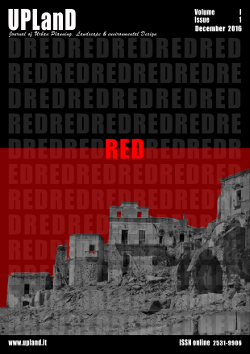Ghost towns and housing discomfort: the landscapes of risk in Italy
Main Article Content
Abstract
Many reasons can lead people to abandon their roots, the places they inhabit. When the abandonment of a place turns out to be a mass phenomenon, the reasons are related, in most of cases, to the concept of risk, a term that has different specificities depending on the context.
The risks, whether of natural origin or related to human factors, are therefore the determining factor of the configuration of the landscapes of abandonment.
The study of the ghost town phenomenon, an extreme phase of the housing discomfort phenomenon, or an effect of a hazard occurred, helps to better understand the scenarios of the risk to a territory, departing from the facts on the ground rather than from hypothetical scenarios, and by relating the hazard contexts with the values actually lost.
The landscapes of abandonment in Italy constitute an objective and widespread condition of lost assets, of risks that have happened. Their comparison with the probabilistic hazard maps (anthropic and structural), through a new perspective.
Downloads
Article Details

This work is licensed under a Creative Commons Attribution-NonCommercial-NoDerivatives 4.0 International License.
Authors who publish with this journal agree to the following terms:- Authors retain copyright and grant the journal right of first publication with the work simultaneously licensed under a Creative Commons Attribution License that allows others to share the work with an acknowledgement of the work's authorship and initial publication in this journal.
- Authors are able to enter into separate, additional contractual arrangements for the non-exclusive distribution of the journal's published version of the work (e.g., post it to an institutional repository or publish it in a book), with an acknowledgement of its initial publication in this journal.
- Authors are permitted and encouraged to post their work online (e.g., in institutional repositories or on their website) prior to and during the submission process, as it can lead to productive exchanges, as well as earlier and greater citation of published work (See The Effect of Open Access).
References
Bassanelli, M. (2010). Tesi di Laurea: Geografie dell’abbandono. Il caso della Valle di Zeri. Relatore: Prof. Gennaro Postiglione Politecnico di Milano
Castellotti, T., Gaudio, F. e Paciola, G. (2008). Quali politiche e quali governance per i piccoli comuni? XLV Convegno di studi della SIDEA, Politiche per i sistemi agricoli di fronte ai cambiamenti: obiettivi, strumenti, istituzioni. Portici(NA), September 25-27, 2008.
Clément, G. (2005). Manifesto del Terzo paesaggio, Macerata, Quodlibet
I Borghi più Belli d'Italia, (2001). database on-line. Retrieved from http://www.borghipiubelliditalia.it/
Di Bitonto, F. (2011). Paesi Fantasma. Paesi e luoghi abbandonati, database on-line. Retrieved from http://www.paesifantasma.it/
European Landscape Convention, (2000). Adopted by the Committee of Ministers of the Council of Europe on 19 July 2000 and opened for signature by its Member States in Florence on 20 October 2000. Retrieved from www.coe.int/en/web/landscape
INGV (2004). Mappa di pericolosità sismica del territorio nazionale OPCM 3274/2003 in Rapporto Conclusivo per il Dipartimento della Protezione Civile, Gruppo di Lavoro MPS, Milano-Roma, aprile 2004.
ISPRA (2015). Dissesto idrogeologico in Italia: pericolosità e indicatori di rischio. Rapporto 2015. Retrieved from www.isprambiente.gov.it
Legambiente, Coldiretti. (2005). L’indagine delle qualità agro-territoriali. Primo rapporto sulle qualità agro-territoriali delle regioni ed il contributo dei piccoli comuni, Roma, 24 febbraio, n129. www.coldiretti.it
Legambiente, Confcommercio. (2000). L’italia del disagio insediativo. Investire Sul Belpaese: servizi territoriali diffusi per la competizione globale. Roma, Serico, Gruppo Cresme.
Legambiente, Confcommercio. (2001). Investire Sul Belpaese, difendere i piccoli comuni per promuovere l’identità e le qualità italiane. Piccola Grande Italia, la disomogenea vitalità dei piccoli comuni con meno di 2.000 abitanti, Roma, Serico, Gruppo Cresme.
Legambiente, Confcommercio. (2007). L’italia del disagio insediativo. 1996/2005. I talenti sottratti alla competizione globale, Roma, Serico, Gruppo Cresme. Retrieved from www.confcommercio.it
Legambiente, Confcommercio. (2008). Rapporto sull’italia del disagio insediativo. 1996/2016. Eccellenze e ghost town nell’italia dei piccoli comuni, Roma, Serico, Gruppo Cresme. Retrieved from www.confcommercio.it
Legambiente, Unioncamere. (2016). Piccolo (e fuori dal) comune. Cosa sta cambiando nell’Italia dei piccoli comuni. Retrieved from www.legambiente.it
Mangoni, F., & Sgobbo, A. (2013). Pianificare per lo sviluppo. Un nuovo insediamento ai margini della metropoli. Napoli, IT: Edizioni Scientifiche Italiane.
Mocciola, A. (2010). Le vie Nascoste, Napoli, Gianmarino Editore.
Ricci, M. (2008). Il rischio del paesaggio. TRIA, Territorio della Ricerca su Insediamenti e Ambiente, 02(2). 47-54.
Ricci, M. (2003). Rischio paesaggio, Roma, Meltemi Editore.
Sgobbo, A. (2016). Recycling, waste management and urban vegetable gardens. WIT Transactions on Ecology and The Environment, 202, 61-72. doi:10.2495/WM160071
Sgobbo, A., & Moccia, F.D. (2016). Synergetic Temporary Use for the Enhancement of Historic Centers: The Pilot Project for the Naples Waterfront. TECHNE Journal of Technology for Architecture and Environment, 12, 253-260.doi:10.13128/Techne-19360
Taormina declaration, “Saving europe’s memory and identity”. (2009). Adopted by the participants of the Europa Nostra Forum on Safeguarding Europe’s Historic Small Towns and Villages and their Surrounding Landscapes, organised in coop. with Italia Nostra, Taormina, Sicily, 4 June 2009. Retrieved from www.europanostra.org
Unioncamere. (2014). Territori comuni dai talenti alle reti, L’Italia del disagio Insediativo. Rapporto 2014. Retrieved from www.piccolagrandeitalia.it

